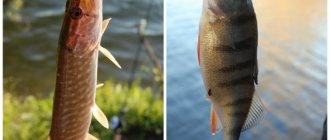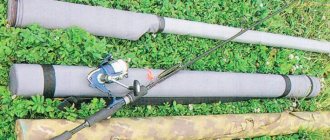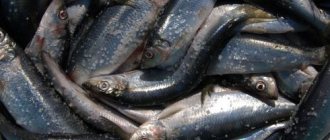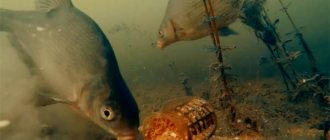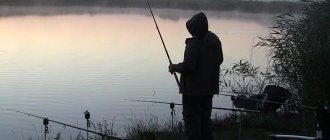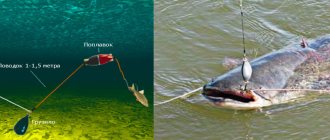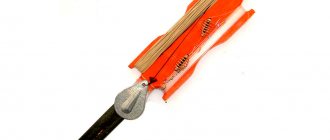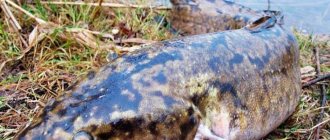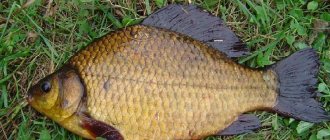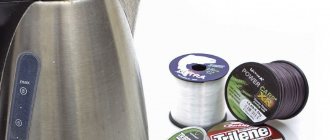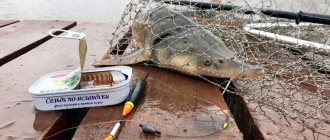What you need to make a donkey from a spinning rod
Undoubtedly, the basis for the bottom device will be the spinning rod itself. We will go into more detail about its differences in characteristics and their advantages based on fishing conditions below, in the next part of the material. It is most rational to equip a fishing rod with a spinning reel, and ideally with the presence of a baitrunner in its design. The reel should not have any special tenderness or grace. Quite rough and inexpensive options with the possibility of wide adjustment of the friction and the presence of a couple of spare replaceable spools are also suitable.
Selecting fishing line and braided line
The braided thread or fishing line as the basis for installation is selected based on the type of fish expected in the catch, the actual installation of the equipment itself and the bottom of the reservoir on which the fishing is carried out. The thickness of the braid is at least 0.2 mm, and it is wiser to use fishing line starting from 0.3 mm. Hundred-meter sections will be quite enough for any reservoirs. As a rule, casting bottom rigs at 50–70 meters is the most acceptable and easy to do. In addition, hundred-meter sections of such sections will fit quite comfortably into medium-sized spools of a reel and will not require additional winding under the base.
Important! A pre-prepared reel with two spooled base options for bottom fishing will be the key to the success of any fishing strategy
Choosing a feeder and load
Moving on to shipping options, one should distinguish between two possible types of equipment that will be used for installation. This:
- loads in the form of feeders;
- flat sliding solid weights.
Without going into too much detail, I can confidently classify cargo mass ranges of 40–60 grams as universal. For most conditions on stagnant, medium and slow-flowing reservoirs, these dimensions work with a bang. Damper beads with diameters corresponding to the thickness of the main thread, swivels and fasteners, stoppers, are also an integral accessory of a bottom fishing rod in our time.
Alarms and stands
Leashes of various lengths and diameters can be prepared ahead of time and kept constantly in the leash. But for those who know how to quickly cope with tying hooks, it is enough to have in reserve two or three spools of fishing line with a diameter of 0.12 to 0.2 mm and a box of hooks of various sizes. Spinning rods for donkeys must be equipped with a bite alarm. The signaling device can be either a regular bell mounted on the main thread of the rod or the tip of the rod, or modern electronic signaling devices with swingers.
Don't forget about the presence of rod stands. Often you can use an ordinary wooden flyer, obtained from nearby bushes, but it is more civilized to have a modern-looking plastic flyer on lightweight prefabricated metal stands or rods. All of the above elements allow you to easily and without special skills make a donkey from a spinning rod.
Spinning rod for bottom fishing.
Yes. It is a simple spinning rod that is still successfully used for bottom fishing. If a fisherman is experiencing certain financial difficulties, or is not ready to switch to specialized fishing tackle, then a regular and cheap spinning rod can provide an indispensable service. It should be borne in mind that rich catches do not always depend on the skill of the fisherman and the high cost of the gear. In this case, the fisherman will suit a spinning rod from the lower price categories. Length within 2-3 meters. The rod blank material can also be simple and cheap. Fiberglass or its composite with graphite will do just fine. Passage rings can also have simple and inexpensive aluminum oxide inserts, which are resistant to braided lines. The objects of fishing can be bream with crucian carp, carp, and even catfish.
How to make a fishing donk
Bottom tackle is not an object of industrial production and is mostly assembled by fishermen individually, for certain fishing conditions. In order to assemble bottom gear with your own hands, a fisherman must have the skills and ability to tie knots and have an understanding of the algorithm for assembling constructs into a single assembly.
The principle of operation of the equipment remains the same in all cases - supplying baits on the main cord with securing the equipment with a weight at the bottom of the reservoir. Next, we will dwell in more detail on the elements necessary for the manufacture of bottom gear with a description of their main operating properties and characteristics.
Read Rating of balancers for perch
fishing line
The donkey rig is formed on the main thread, which for short distances, up to 25 meters, is selected from monofilament fishing line, and for fishing at medium and long distances, a braided cord is used. The monofilament base is taken with a diameter of at least 0.2 mm, with the possibility of the fishing line being self-immersed under water and preferably in more stringent parameters. As a rule, clear fishing lines are universal for all shades of water. Braided cords for donk tackle begin to be used from a diameter of 0.15 mm. Braids, as well as monofilament, are chosen with strict characteristics, and when using this type of cord, the green shades of the material are most effective for all types of reservoirs, and in different seasons of the year.
Sinker
Donka fishing can be done with either a dead or sliding weight. For the most part, teardrop-shaped lead sinkers are used for standing and weakly flowing reservoirs and flat types of shapes for rivers with moderate and fast currents. Drop-shaped weights and olive-shaped weights are not so noisy when casting, but do not stay on the bottom in currents, which, in contrast, ensures flat figures that are noisier when casting into fishing zones. A weight weighing 70 - 150 grams will more than ensure fishing in still waters, but for currents it is sometimes necessary to install a stationary weight of 500 grams or more.
Leash
The leader material is selected based on the type of fish being caught. For pike, use metal or Kevlar leashes. Catfish and pike perch attack baits on braided leashes without causing any special deformation to them
All peaceful fish, depending on their caution and activity, can be successfully caught using monofilament or fluorocarbon leader materials. The length of the leash depends on the activity of the fish, the way it feeds and the structure of the bottom at the fishing location
For active fish, short leashes are used, the sizes of which fall in the range from 15 to 25 cm. For passive fish and when fishing in silted reservoirs, longer leash sections are used. Additionally, under these conditions, leashes are equipped with foam floats, often the size of a pea to a walnut, which ensures that the bait is kept in the water horizon required for fishing.
Hooks
Hooks for equipment are selected based on the bait used and the size of the fish expected to be caught. It is better to prepare leashes with hooks at home in advance, on the shore only by retrofitting the tackle and without spending extra time on tying. For vegetable baits, use hooks with a short shank in the color of the bait. For animal bait in the form of a worm and crawler, as well as live bait fish, hooks with an elongated shank in blue and steel colors are used. In some cases, when setting fry as bait, it is effective to use a double and tees according to the size of the fish used for fishing. The shape and type of the connecting element of the accessory, be it a blade or a ring, do not fundamentally affect the installation design.
Best jig reels
Mikado CRYSTAL LINE 3006 FD1 600 For fishing with jig baits of different sizes, the Mikado CRYSTAL LINE 3006 FD spinning reel is suitable. It has a front clutch adjustment, an instant stopper is located at the back in the form of a flag. The body is made of graphite and comes with two spools. One is made of graphite, the other spool is made of duralumin with titanium nitride coating on the sides. For smooth running, the design includes 5 ball and 1 roller bearings. The gear ratio of the “meat grinder” corresponds to 5.5:1. The 3000 spool holds 120 m of 0.28 mm monofilament. The weight of the product is 303 g. The handle can be rearranged. The best inexpensive all-around jigging reel. Main advantages:
Minuses: When reeling in the fishing line, a beating is felt. | 9.8 / 10 Rating Reviews I have one spinning rod for all occasions. I equipped it with an inexpensive Mikadov coil. I fish both on lakes and rivers. “Meat grinder” copes with its tasks with 5 points. There are small gaps, but they do not yet affect the performance. |
RYOBI EXCIA MX 30004 500 The RYOBI EXCIA MX 3000 spinning reel is one of the fishing bestsellers. The popularity of the model is ensured by thoughtful ergonomics and high-quality materials. The gear ratio of the model corresponds to 4.9:1. Smooth running is ensured by 8 ball and 1 roller bearings. It is convenient to use the front clutch with fine adjustment. Stable operation and high-quality winding during jig wiring are made possible thanks to the endless screw. The durability of the perforated spool is ensured by a titanium nitride rim. The weight of the product is only 290 g. The spool capacity is 300 m of 0.2 mm monofilament. The best budget fishing reel for jig masters. Main advantages:
Minuses: noisy line roller. | 9.8 / 10 Rating Reviews The reel has been working properly for 3 seasons. At this price, there are no complaints about the “meat grinder”. The cord fits perfectly, is not killed, you can use a 4000 spool. It’s such an unpretentious thing that even without maintenance everything still spins! |
Abu Garcia Ambassadeur SX-6600 (6601)9 025 The Ambassadeur SX 6600 (right-handed) or SX-6601 (left-handed) multiplier reel is designed for spinning casting with lures weighing up to 50 g. The frame body in combination with a lid made of aircraft aluminum gives strength and lightness. The aluminum spool allows you to use braided cords with a diameter of up to 0.35 mm. The gear ratio of 5.3:1 ensures effective landing of a trophy predator. The spool's line capacity is 230 m of thread with a thickness of 0.38 mm. The mass of the multiplier is 320 g. For smooth rotation, the reel has 3 ball and 1 roller bearings. The best multiplier for heavy jig in our rating. Main advantages:
Minuses: on the river it is better to limit the weight of the bait to 40 g. | 9.8 / 10 Rating Reviews I switched to multipliers a long time ago with a passion for heavy jigs. I tested the reel in the harsh conditions of the Lower Volga. Among the trophies I can boast of a 5.5 kg pike perch and a 7.6 kg catfish. The cartoon worked well all season. |
Donka with a spinning rod feeder: making and catching
You can also fish with a donkey with a feeder using a spinning rod, but it is worth noting that such tackle will be clearly inferior to a feeder rod in full-fledged feeder fishing.
And here's why: • The tip of any spinning rod is not as sensitive as the tip of a feeder rod, but in bottom fishing this is important, and since an angler who is going to make a donk from a spinning rod will most likely use a telescopic spinning rod, there is no need to talk about the sensitivity of the tip has to. • The rod test is noticeably weaker than almost any feeder rod
If you can easily cast a 30 g feeder filled with food, then 50 g or more (and in the current, fishermen use all 100 g) will be very difficult, due to the fragility of your gear, you will not be able to cast sharply. • The length of the spinning rod is always less than the length of the feeder rod. This is also a big minus for casting distance.
If you are ready to fish with a bottom spinning rod at not very long distances (no more than 50 m) with feeders up to 50 g, then our guide will try as much as possible to help you create the most sensitive bottom as possible.
Donkey device with feeder
Since we are using a feeder, one way or another, it is better to use one of the feeder equipment. You have two options: • when catching large fish, choose an asymmetrical loop, inline or method (self-hooking rigs) • when catching small fish, choose a paternoster (a rig that transmits even weak bites to the tip of the rod).
No. Well, of course, you can not use any equipment at all, but simply tie the feeder to the fishing line, and behind it there is a hook on a leash. Or a feeder at the end, and a leash with a hook leading to the feeder. But all these options are significantly worse than any feeder equipment.
To make a donkey from a spinning rod with your own hands, we will need:
spinning rod for donkeys, the longer the better, preferably made of carbon; inertia-free coil, parameters do not matter, it is only important that the clutch works; monofilament with a diameter of 0.25-0. 3 mm;
a “cage” type feeder weight in the case of a paternoster, and a “spring” or “method” in the case of inline or method equipment; a hook of the desired size (the main thing is that it fits easily in the mouth of the intended fish).
Stages of equipping a spinning rod with a donkey
- A reel is inserted into the spinning rod.
- The line is wound onto the reel.
- The fishing line is threaded through all the rings.
- Next, we tie the equipment of your choice (we advise beginners to take a paternoster, this is a very good equipment for fishing on a muddy bottom and will work perfectly as a sensitive tackle on a hard bottom).
The paternoster looks like this:
The leash is made from thinner fishing line (0.2-0.25), and it is best to use fluorocarbon fishing line, it is invisible in the water, one 25-meter reel will last you the whole season.
Donk fishing technique with a feeder
We recommend adhering to the feeder rules for bottom fishing: Make 10-20 starting casts of your feeder filled with bait. The feeder should reach the bottom and only when you feel that the feeder has reached the ground - after your strong hooking, the food should be shaken out of the feeder. This is especially true when fishing in the current.
The bait should not spill out of the feeder when it comes into contact with water. How to constantly throw a feeder in the same place? Good question, very simple. Make the first cast to the desired location (taking into account the fact that at such a distance you can cast many more times).
Place the line near the reel behind the clip (most often this is a triangular stopper on the spool of your spinning reel). Now pull out the feeder, fill it with food and cast it again along the landmark on the opposite bank.
Firstly, this is no longer sport fishing, and secondly, you will simply make too much noise in the fishing area, this will negatively affect both the fish and the attitude of amateur fishermen or athletes fishing near you. All bites are clearly visible even without a bell; moreover, the bell is simply unable to detect many bites.
If the fish has not bitten for more than 10 minutes, take out the equipment, check the bait, add bait, and send it back to the working area. What can you catch with such a donkey? Anything: crucian carp, roach, bream, silver bream and even carp and perch. But be sure that if you like this activity, it is better to move in the direction of buying a good feeder rod and fish with a full-fledged feeder. You will immediately appreciate the scope of the new possibilities.
https://primanki.com/snasti/fider/donka-s-kormushkoj-iz-spinninga.html
Disadvantages of such gear
Tackle in which the spinning rod is not used for its intended purpose is inferior to the feeder in almost all respects:
- Donka from a spinning rod does not have a sensitive tip, which is used to record bites in feeder fishing. Confident, strong bites can be noticed, but cautious ones may not be recognized even with the use of additional indicators.
- The length of the rod is small. Spinning rods longer than 2.7 meters are rare, which means you can’t count on a long casting distance. And even if the current is strong, you won’t be able to fish – a light feeder or sinker will simply be carried away.
- The test for such fishing rods, as a rule, is relatively small (with the exception of Chinese versions, the real test of which, apparently, is not known to the manufacturer himself). This negatively affects both the casting range and the possibility of fishing in the current.
- Often, with such conversion, the fishing rod has to be overloaded, which negatively affects its service life.
Making zakidushki and postavushi
These two bottom tackles are considered classic. We have combined them into one chapter, since the fishing rods differ only in the method of fishing, but in terms of installation they are identical.
Reel
We begin assembling the stash by selecting a suitable reel for the donkey, on which the rest of the equipment is assembled, stored and transported.
When constructing a reel, it is advisable to provide for the possibility of attaching it to the shore, for example, using a riveted skewer.
Reels are used from a variety of materials, depending on what you have at hand. For example:
- cut out of plywood or wooden board;
- cut from polystyrene foam or polystyrene;
- bent from smooth metal reinforcing wire;
- use purchased plastic models.
Advice! If you are going to do donks seriously, treat the manufacture of reels with due respect and make them well!
Many fishermen mount equipment on large inertial reels for donkeys of the “Nevskoy” type, attaching them to a metal stand.
A donka equipped with a large reel is more mobile in use than a tackle with a reel.
Main line
Once you have decided and made the base of the donkey in the form of a reel or structure with a reel, proceed to winding the fishing line. The donkey equipment must be durable and strong, so monofilament from 0.30 millimeters in diameter to 0.45 is used as a base. The first option is used for fishing in still waters, the second - on the current.
The amount of fishing line depends on the distance at which you intend to fish. For some, 20 meters will be enough, for others, 50 will not be enough, calculate for yourself.
Leashes with hooks
The number of leashes used on homemade hooks rarely exceeds five. You should not chase quantity, remembering that extra hooks interfere with the equipment of the fishing rod, and snags during fishing will be more likely.
It is best if the leashes are mounted on a separate insert in the form of a so-called garland. They are equipped on both sides with carabiners with swivels for attaching to the main fishing line for quick replacement. The diameter of the fishing line should be 0.02 millimeters thinner than that of the base.
It is best to knit leashes to the insert using the loop-to-loop method or a running knot. Read more about this in the article “How to knit leashes.” The thickness of the leader line depends on the intended trophy: from 0.10 millimeters for catching roach, to 0.25 when hunting burbot or carp.
To prevent the leashes from overlapping, a mounting with beads is used, between which the leashes are placed. Attention! To prevent the donkey leads from tangling with each other, the distance between the mounting points must be greater than the sum of their lengths.
The choice of hook depends on what kind of fish you plan to catch and what bait you use. For fishing with bloodworms or maggots, the smallest models are used; for fishing with live bait, doubles or trebles are used.
Sinker
The sinker is selected based on the following considerations:
- it must securely hold the tackle at the fishing point;
- be convenient for casting from hand to the optimal distance.
You can attach the sinker to the rig directly or through a carabiner. In the second option, you can quickly change it to a feeder or a model of a different weight and shape.
Feeder
When catching peaceful fish on a homemade donka, you can use equipment not only with a weight, but also with a feeder. This element is especially important when fishing for carp fish with various types of smoktukhs.
When fishing with smoktukha, foam balls are often caught on hooks.
Bite alarms
To signal a bite on a donk, various sound or visual devices are installed:
- bells;
- bells;
- pendulums;
- electronic devices;
- fireflies.
This device combines audio and visual signals.
Installation of equipment
They collected the donka from the spinning rod that was at hand. Now all that’s left to do is to weave the rigging.
As already mentioned, feeder installation schemes are used:
- Paternoster.
- Gardner's loop. In my opinion, the most common and easiest installation to make.
- Asymmetrical loop. Sensitive and not prone to tangling in the current circuit.
- Symmetrical loop. Often used when fishing in reservoirs without current.
- “Helicopter”, like a slightly modified version of Gardner.
- Inline, when the feeder is fixed on the main line itself and its movement is limited by stoppers. The hook on the leash is attached to the end of the main line.
I will not consider the “crucian carp killer” when 2-3 feeders are installed. This is a separate topic. And despite the efficiency, it’s still somewhat unsportsmanlike.
So. The simplest, but no less effective, is the Gardner loop. Using this as an example, we will equip our spinning rod donka.
The Gardner loop is knitted on the main line. We passed the line through the rings, drew out a section convenient for work, and began to install. 50 cm is quite enough.
- We measured and made a loop 10 centimeters long. We knit according to tradition with a simple and reliable figure eight knot.
- We attach a swivel with a carabiner in the resulting loop, and a feeder to it. You can attach the feeder directly to the fishing line, but with a carabiner it is more convenient to replace the container if necessary.
- We apply a free piece of fishing line and 3 centimeters below the feeder we tie another loop, smaller in size, for further fastening the leash.
The outlet is made longer than the feeder connection so that in the future, when casting and fishing, the installation does not get confused.
- The length of the leash with a hook varies among fishermen. There is a direct dependence on the size of the spinning rod. To put it bluntly, casting a rig with a long overhang with a short rod is inconvenient. For my installations, I use a leash length of no more than 30 - 35 centimeters. With a spinning rod height of 2.40, it is quite convenient to cast.
The Gardner rig is sensitive to fish bites and allows you to fish in almost any bottom topography and bottom condition. Be it silt, sandstone, shell rock, plant carpet.
Donkey rigging
Today there are dozens, if not hundreds of different equipment for donkeys. It is simply impossible to describe them all. Let's focus on the most common and reliable options.
Simple option
Despite its simplicity of equipment, this option is perfect for fishing for the largest trophy fish. In this case, only one node is used, so the strength of the equipment is beyond doubt.
We attach a sliding sinker in the form of a teardrop shape or an olive to the fishing line. To fix the sinker, you must use a silicone clamp. Remember that the stopper must be fixed firmly and rigidly enough. When casting the tackle, a significant load is placed on the stopper, but at the same time it must maintain its position. We can recommend that you use a soft lead pellet, which is clamped on the fishing line, as such a reliable stopper. A hook is tied to the end of the fishing line without a leash. It is also possible to rig it using a leash, which is attached through a swivel.
Equipment with spring
With equal success, a donkey rig with a spring is suitable for fishing with a rod and with hand casting. Equipment with a spring is especially effective when fishing in lakes and rivers with calm water.
The first option is a sliding donkey with a spring. In our case, we replace the sliding sinker of the donkey with a spring. Viscous porridge or peas are easily stuffed into the spring. The choice of bait directly depends on the type of fish and its specific preferences in your pond.
The advantage of sliding equipment is that the fish does not feel resistance when biting, which is necessary for catching cautious and large fish. In the second version of the rig, short leashes are installed on the spring, which are recessed into the bait located in the spring
In fact, in this case, the bait is used as feeding and bait. The second option is perfect for catching bream and carp. In this version of the rig, the fish detects itself, and the fisherman only needs to pull it out of the water. We can recommend that you use braided fishing line with a thickness of 0.1 - 0.15 millimeters for leashes.
In the second version of the rig, short leashes are installed on the spring, which are recessed into the bait located in the spring. In fact, in this case, the bait is used as feeding and bait. The second option is perfect for catching bream and carp. In this version of the equipment, the fish detects itself, and the angler only needs to pull it out of the water. We can recommend that you use braided fishing line with a thickness of 0.1 - 0.15 millimeters for leashes.
If you are fishing in a strong current or there are deep holes and a sharp change in depth, it is recommended to install flat sliding sinkers directly in front of the spring. Such a flat shape of the sinker will not allow it to be carried away by the current.
Bait, groundbait and methods of its delivery
Any bait and bait can be used, but it is worth considering that for bottom fishing, animal baits are more suitable, which stand out at the bottom not only by smell, but also by movement. The use of bait is influenced by both the target fish and the time of year. Both homemade compositions and store-bought bait, as well as their combinations, can be used equally successfully.
If it is possible to feed the fishing point by hand, or using a slingshot, it is better to give preference to these methods, since in this case it is possible to somewhat reduce the load on the spinning rod, which, when used as a rod, is often overloaded.
A spinning rod with a feeder is one of the most popular gear among fishermen, as it is suitable for catching almost any type of fish and is highly effective.
Let's take a closer look at the features and use of the gear. The disadvantages of using donks include attachment to a specific area of the reservoir and labor-intensive removal of prey and all gear at the end of fishing.
Thanks to the naturalness of the baits located on the bottom and the design features of the tackle, donks are characterized by enviable catchability. Spinning rod, about 2m long (or fishing rod). Tip: the length of the spinning rod must meet the angler’s requirements, taking into account the distance of casting the feeder from the shoreline or boat. The optimal length is about 2.5 m.
Inertia-free reel (spool size 3000). Advice: You should choose a multifunctional reel in order to prevent unforeseen situations with the main fishing object - large predatory fish.
Monoline , 100m long and about 0.3mm in diameter.
Lead line , 20 m long and about 0.2 mm in diameter.
Feeder sinker , weighing 40–100 g (weight depends on the type of fish). Advice: for each reservoir, the optimal feeder is selected based on color, weight, type of bait, but it is recommended to stock up on a variety of types during fishing.
Hooks of appropriate sizes (No. 6, No. 7, No. 8). Advice: in any situation it is necessary to have a set of leashes with different sizes of hooks and thickness of fishing line, since it is impossible to predict the bite.
Bite alarm (electric device, bells, floats, etc.).
None A reliable stand for a spinning rod that can withstand jerking fish.
With the help of a donkey, it is possible to study a reservoir by moving along the coastal line.
Over 7 years of active fishing, I have found dozens of ways to improve the bite. Here are the most effective ones:
- Bite activator . This pheromone additive attracts fish most strongly in cold and warm water. Discussion of the bite activator “Hungry Fish”.
- Increased gear sensitivity. Read the appropriate manuals for your specific type of gear.
- Pheromone -based lures .
[custom_ads_shortcode1]
Main line
Two types of fishing lines are used in spinning rods:
- braided cord;
- monofilament line.
Braid is more expensive, but with the same diameter as monofilament, it is much stronger. That is, for the donkey you can take a braided line of a smaller diameter, which will be less noticeable and fly better.
https://www.youtube.com/watch?v=JWhqzYBJ_7w
Disadvantages of braid:
- high cost compared to monofil;
- low extensibility.
In addition, many braided lines in the budget segment are poorly colored, and after several fishing trips all their camouflage is washed off.
Monofilament line will stretch minimally, while braided line will not stretch at all. If the line is stretched too much, you may not notice the fish biting.
Monofilament and braided versions will not allow this. The diameter of the fishing line should be 0.3 mm (catch from 10 kg).
One hundred meters for spinning will be enough.
It is best to equip a spinning rod with one hundred meters of monofilament or braided fishing line. Depending on the thickness of the fishing line, visibility in the water and the weight of the prey will depend.
- sinker (feeder);
- fishing line;
- leash with hook;
- rod (reel).
On the simplest donk (skid) a terminal (for current) and sliding (for standing water) sinker are used. Monofilament fishing line is used with a thickness of 0.3-0.5 mm with a low elongation coefficient and a tensile strength of 5-12 kg. The braid is selected with the same tensile strength. The leashes are knitted from fishing line 0.1 mm thinner than the main one. The hook size corresponds to the intended prey.
Zakidushka is a mobile tackle and allows you to search for fish in an unknown body of water.
What you will need
To begin with, you must have a spinning rod, if you don’t have one, quickly go read the article about choosing a fishing rod for donkey, because this aspect greatly influences fishing. Depending on the conditions, the length of the rod may vary; short models are better suited for standing reservoirs, respectively, long ones for rivers.
Secondly, you need to decide on the coil. Here I can give the only recommendation: the reel for the donkey should only be inertialess. There are still anglers who have inertial reels installed.
Of course, if you have steel balls and iron fingers, and you can hold the inertial reel when casting, then you can use these. In general, if you rely on convenience and efficiency (efficiency factor), then the inertia engine performs in all respects.
Please note that if the reel fits the spinning rod according to the mount, it may happen that the mount does not fit into the holder! Now you need to decide on the fishing line. Here everyone has their own preferences, some use braided cord, some use monofilament. In fact, when fishing with a bottom, this does not play a big role, unless, of course, you are catching catfish.
The choice of fishing line has its own nuances. For example, if you are counting on a big fish (for fuck’s sake, who doesn’t count on it?
